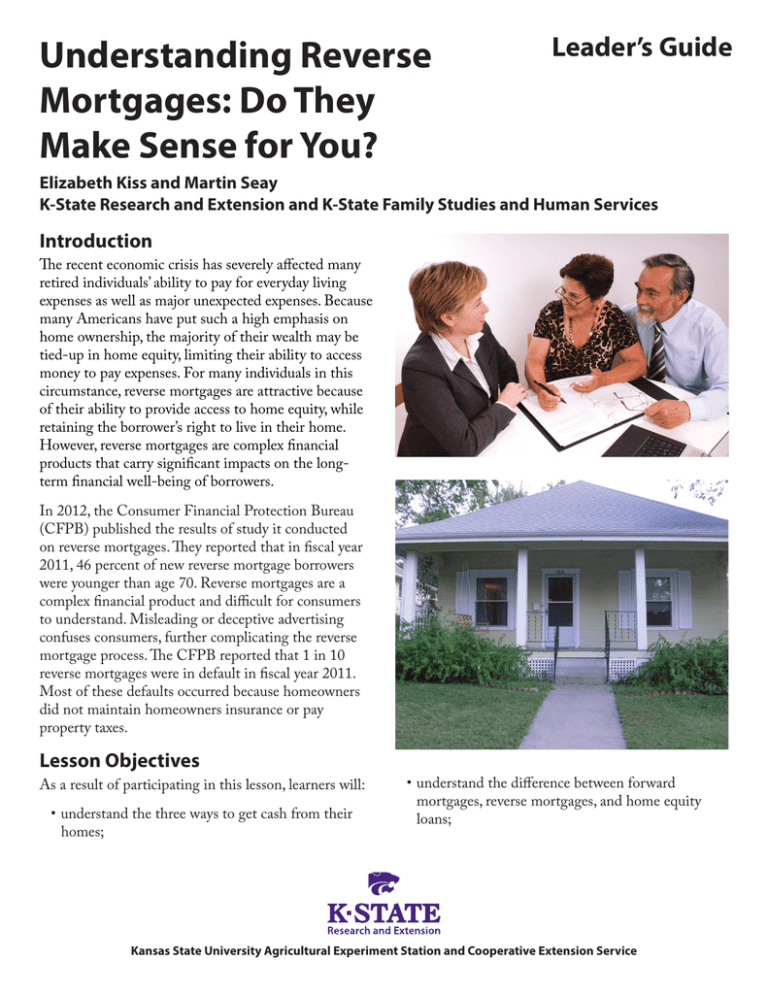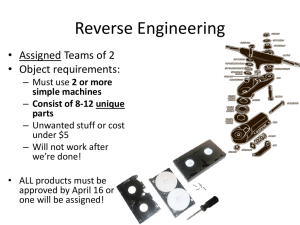
Understanding Reverse
Mortgages: Do They
Make Sense for You?
Leader’s Guide
Elizabeth Kiss and Martin Seay
K-State Research and Extension and K-State Family Studies and Human Services
Introduction
The recent economic crisis has severely affected many
retired individuals’ ability to pay for everyday living
expenses as well as major unexpected expenses. Because
many Americans have put such a high emphasis on
home ownership, the majority of their wealth may be
tied-up in home equity, limiting their ability to access
money to pay expenses. For many individuals in this
circumstance, reverse mortgages are attractive because
of their ability to provide access to home equity, while
retaining the borrower’s right to live in their home.
However, reverse mortgages are complex financial
products that carry significant impacts on the longterm financial well-being of borrowers.
In 2012, the Consumer Financial Protection Bureau
(CFPB) published the results of study it conducted
on reverse mortgages. They reported that in fiscal year
2011, 46 percent of new reverse mortgage borrowers
were younger than age 70. Reverse mortgages are a
complex financial product and difficult for consumers
to understand. Misleading or deceptive advertising
confuses consumers, further complicating the reverse
mortgage process. The CFPB reported that 1 in 10
reverse mortgages were in default in fiscal year 2011.
Most of these defaults occurred because homeowners
did not maintain homeowners insurance or pay
property taxes.
Lesson Objectives
As a result of participating in this lesson, learners will:
•understand the three ways to get cash from their
homes;
•understand the difference between forward
mortgages, reverse mortgages, and home equity
loans;
Kansas State University Agricultural Experiment Station and Cooperative Extension Service
•know what factors to consider when evaluating a
reverse mortgage; and
•become familiar with the product features,
eligibility requirements, costs, available loan
amounts, and borrower obligations associated with
the most common reverse mortgage product, the
Home Equity Conversion Mortgage (HECM)
from the Federal Housing Administration.
Intended Audiences
Adult homeowners and their families.
Before the Lesson
•Review the Understanding Reverse Mortgages: Do
They Make Sense For You? fact sheet (MF3163) and
leader’s guide (MF3164).
•Obtain copies of the fact sheet for each participant.
Make copies of the cards for Activity 2 (if using)
and the evaluation for each participant.
•Assemble other supplies you may want to use (e.g.
flipchart, markers) and gather materials needed for
the activities in the lesson that you choose to do.
•Become familiar with the references and resources
for this lesson.
•Discuss the lesson with an HECM approved
counselor. Find an HECM counseling agency near
you at https://entp.hud.gov/idapp/html/hecm_agency_
look.cfm
•Arrange chairs in a circle or semicircle to encourage
discussion and participation.
Presenting the Lesson
Share “ground rules” of the session with learners,
adapted from Making Your Money Work, Purdue
University Extension, Trainer’s Guide (CFS-679G).
1. Respect the views of others.
2. Listen to each other.
3. Share feelings/thoughts.
4. Be open to new ideas.
5. Suspend judgment.
2
Summarize objectives. Ask learners if there are other
issues they came to learn about. Make a list of those
issues on a whiteboard or flipchart. Address them as
time and knowledge allow. Offer to research issues as
needed and respond to the participant after the lesson.
Present the lesson using the fact sheet and the
information in the resources included there for
content. Incorporate one or both of the activities
below.
Have learners complete and return evaluations to you.
Enter results into K-PICS.
Lesson Activities
Activity 1 – “Stand Up/Sit Down”
After presenting the lesson, this activity seeks to
gauge learners’ knowledge and understanding of
the differences between forward mortgages, reverse
mortgages, and home equity loans.
1.Assign learners to one of three smaller groups
representing different financial products. The
groups are: A) forward or traditional mortgage,
B) reverse mortgage, and C) home equity line
of credit or installment loan. You can do this by
counting off, drawing, or another method of your
choice.
2.Test their understanding by reading the following
statements and asking them to stand if the
statement applies to their financial product. Have
learners return to their seats between statements.
Answers are in parentheses.
a. Generally available to any adult. (A, C)
b. Generally available to anyone 62 or over. (A, B,
C)
c. Available to only those 62 and over. (B)
d. Requires monthly payments. (A, C)
e. Over time my equity increases. (A,C)
f. Over time my equity decreases. (B)
g. Requires loan counseling. (B)
h. Retain ownership to my home. (A, B, C)
i. Interest and fees accumulate each year. (A, B, C)
K-State Research and Extension — Understanding Reverse Mortgages, Leader’s Guide
Activity 2 – “Does a Reverse Mortgage Make
Sense for Me?”
Once learners have a basic understanding of the
differences between forward mortgages, reverse
mortgages, and home equity lines of credit and
installment loans, they can begin to consider whether
or not a reverse mortgage makes sense for their
situation.
1. Create a set of “Does a Reverse Mortgage Make
Sense?” cards making sure to have enough so that
each of your learners can have at least one. The
cards are on page 4 of this leader’s guide.
2. Distribute the “Does a Reverse Mortgage Make
Sense?” cards to the group.
3. Working in groups of two or three learners, ask for
a volunteer to read one of the cards.
4. Ask participants in the small groups to respond. In
this situation…
a. What things would I need to consider?
b. What additional information might I want to
gather?
c. Who might I want to discuss this with?
Refer to the fact sheet for examples.
Community Awareness Activities
•Talk with friends and family members about what
you learned from attending a program on reverse
mortgages.
•Place copies of the fact sheet in your local library
and senior center.
•Work with a local newspaper to sponsor one or
more news articles on topics related to the content
of the lesson.
Authors
Elizabeth Kiss, Ph.D., Assistant Professor and
Extension Specialist, School of Family Studies and
Human Services, Kansas State University,
dekiss4@k-state.edu
Martin Seay, Ph.D., CFP, Assistant Professor, School
of Family Studies and Human Services, Kansas State
University, mseay@k-state.edu
Reviewers
Debra Wood, M.S., CFP, Central Kansas District
Family Resource Management Agent
Susie Latta, M.S., Marshall County Family and
Consumer Sciences Agent
Diane Burnett, M.S., Marais des Cygnes District
Family and Consumer Sciences Agent
Lloyd G. Zimmerman, M.S., CFP
K-State Research and Extension — Understanding Reverse Mortgages, Leader’s Guide
3
My husband and I live in the house that he grew up in. It is
important to us that the house stays in the family.
In this situation…
In this situation…
What things would I need to consider?
What things would I need to consider?
What additional information might I want to gather?
What additional information might I want to gather?
Who might I want to discuss this with?
Who might I want to discuss this with?
Money is tight right now. If I stay in my home, how will I pay for
the maintenance and taxes?
I’m not sure if I want to stay in my house as I get older, but money
is tight right now. It would be nice if I could use the equity in my
home.
In this situation…
In this situation…
What things would I need to consider?
What additional information might I want to gather?
What things would I need to consider?
What additional information might I want to gather?
Who might I want to discuss this with?
Who might I want to discuss this with?
My children seem to expect that when I can no longer live on my
own, we will sell the house and I will move in with them.
It doesn’t really matter to me where I live, but I do want leave
something for my children and grandchildren.
In this situation…
In this situation…
What things would I need to consider?
What things would I need to consider?
What additional information might I want to gather?
What additional information might I want to gather?
Who might I want to discuss this with?
Who might I want to discuss this with?
4
As we grow older, living at home can become difficult. Despite
that, it is important to me to stay in my home as I get older.
K-State Research and Extension — Understanding Reverse Mortgages, Leader’s Guide
Does a Reverse Mortgage Make Sense for Me? — Case Study Cards
Understanding Reverse Mortgages: Do They Make Sense For You? Evaluation
As a result of participating in this lesson:
I understand that it is important to assess whether my home will allow me to age in place.
Yes
No
I understand that I retain ownership of my home with a HECM.
Yes
No
I understand that while no payments are due, failure to maintain the property and pay property
taxes could result in a HECM loan default.
Yes
No
I understand that interest and fees accumulate each year on the HECM loan balance.
Yes
No
I understand that the HECM must be repaid if I move or at my death.
Yes
No
I understand that it is possible that my heirs may be forced to sell my home to pay off the loan
balance.
Yes
No
I know how to find a HUD approved HECM housing counselor.
Yes
No
Actions I plan to take as a result of this lesson:
Why am I asking for contact information? To help us improve this program, we want to know about the behaviors
changed or actions taken by participants after participating in this lesson. If you are willing to provide us with follow-up
information 30-60 days after your participation, please provide your contact information. Your participation is entirely
voluntary and your information will not be used in any other way.
Name:
Phone:
Email:
Address:
City:
ZIP:
K-State Research and Extension — Understanding Reverse Mortgages, Leader’s Guide
5
Publications from Kansas State University are available at: www.ksre.ksu.edu
Publications are reviewed or revised annually by appropriate faculty to reflect
current research and practice. Date shown is that of publication or last revision.
Contents of this publication may be freely reproduced for educational purposes.
All other rights reserved. In each case, credit Elizabeth Kiss, Ph.D., and Martin
Seay, Ph.D., Understanding Reverse Mortgages: Do They Make Sense for You?, Leader’s
Guide, Kansas State University, August 2014.
Kansas State University Agricultural Experiment Station and Cooperative
Extension Service
K-State Research and Extension is an equal opportunity provider and employer.
Issued in furtherance of Cooperative Extension Work, Acts of May 8 and June
30, 1914, as amended. Kansas State University, County Extension Councils,
Extension Districts, and United States Department of Agriculture Cooperating,
John D. Floros, Director.
MF3164
August 2014


